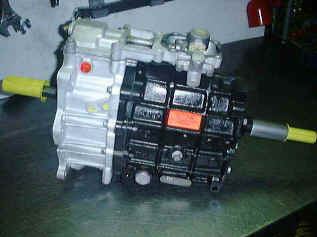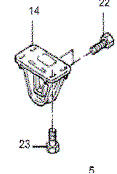Engine & Gearbox Basics
| Engine Type V8 Bore 94,00 mm (3.7 in) Stroke 71,12mm (2.8 in) Number of cylinders eight Cylinder capacity 3950cmJ (241 in) Firing order 1, 8, 4. 3, 6. 5. 7. 2 Power output 185 bhp (Range rover power output quoted- will be more with correct fueling etc) |
Ignition coil Bosch 12V electronic Distributor type Lucas 35 DLM8 Distributor air gap 0.20 to 0,35 mm (0.008 to 0.014 in) Compression ratio 9.35:' Spark plug type Champion RN 9YC Spark plug gap 0,84 to 0,96 mm (0.033 -0.038 in) Ignition timing (dynamic) (vacuum pipe disconnected) 4° BTDC +/- 1' at 800 rev/min max Exhaust gas CO content at idle (non-Catalytic only) 0,5 to, 1.0% |
| Fuel required 95 RON unleaded or 97 RON leaded (non-catalytic vehicles) Idle speed 700 +/- 28 rev/min Note: With the exception of 1he exhaust gas CO content, all of the above details apply to both catalytic and non-catalytic vehicles. Use UNLEADED ONLY (95 octane minimum) for vehicles with catalytic converters. |
Fuel injection system Lucas 'Hot Wire' Fuel pump. electrical AC Delco high pressure Fuel pump delivery pressure 1,83- 2,5 kg/cm- (26- 36 lb/in) Fuel filter Bosch in-line canister type Tappets Hydraulic. :Non adjustable Lubrication System Wet sump pressure fed Oil pressure 1 .97 kg/cm: (28 psi, 1.93 bar minimum at 2000 rev/min |
UPDATED June 05
The 3.9 V8 engine fitted to the G33 was pretty much out of the crate as supplied by Rover, the only changes being a different air filter (K & N) and fitment of Ginetta's bespoke exhaust system. Ginetta then quoted a hopeful 205 bhp with these minor changes over the Range Rovers 180 BHP output. Engine where purchased from TVR power, but don't get excited, they simply had the buying power to get them from Land Rover to supply the smaller manufactures. A few cars did have tuned 4.5, 300 + bhp engines fitted, and one owner said that this power through the standard chassis was inclined to fracture the windscreen! There is a world of information on tuning this engine that I will not add to here, but just a few points of interest on this particular engine set-up.
General Notes on the 3.9
The 3.9 engines head was a later derivative of the 190 bhp 3.5 “vitetess” unit fitted to the Rover SDI. This head had wasted valve stems over the earlier engines for more power, plus the engine had now been bored out. The further later increases in size obtained by TVR and Range Rover required an increase in stroke and bore and accordingly change in crank and block. Ginetta did retain the standard cast exhaust manifold that did not flow that well, so a common mod is to get a free flow tubular manifolds fitted. As 3.9 block is simply the old 3.5 bored out pretty much as far as it will go and consequently the engine is not the strongest of the V8 range (the latter 4.2 and 4.5 are much stronger blocks) and should not be abused by over revving or allowing it to run lean. The maximum RPM is around 6500 for short bursts only, as maximum power is around 5200 rpm, and over-revving it may make it run very lean, that can cause piston damage and this problem must be addressed to prevent expensive damage. The hydraulic cam followers do however limit the engine RPM to a certain extent as they "pump up" and hold the valves open a fraction.
Gearbox

| 1st | 3.32:1 |
| 2nd | 2.90:1 |
| 3rd | 1.40:1 |
| 4th | 1:1 |
| 5th | .79:1 |
| Reverse | 3.43:1 |
| Final Drive | 3.14:1 |
Gearbox Ratios
The gearbox is the 5 speed LT77 gearbox that has been used in the Rover SD1, early Range Rover, Land Rover Discovery, and Sherpa van. There are various versions of this box over the years, that involved strengthening the gear train (although out and out BHP capability has never been a problem up to 300 BHP), changes in gear ratios and synchromesh. The H suffix box used by the Ginetta had a modified (strengthened) syncromesh, but in doing so gear selection problems in 2nd and 3rd became apparent as the new syncromesh could not cut through cold EP80 /90 gear oil to allow the gear speeds to match. Land Rovers easy answer to to use the very thin automatic transmission oil. Many gearboxes subsequently failed early with bearing failure due to the lack of proper lubrication. This was not helped by some bearings being starved of oil due to poor design. Modern synthetic oils overcome the problem to a greater extent, including using fully synthetic 20/50 multi grade. There is a now synthetic oil specifically designed for this gearbox from a company called Difflock. Halfords also do Castrol SMX that I can recommend, from memory you need 2 bottles at around £12-15 each. (The manual says you need 2.7 ltrs, but mine was full at 2 lts). There is a bolt you can remove to drain the box, and one halfway up on the side the refill it. Its a real pain to fill due to lack of access, and the easiest way is to get a bit of clean garden hose and feed it down from the engine bay to the side of the gearbox and into the filler hole. You can then pour the oil in from the engine bay, until it runs back out when the gearbox is full. The only down side is it makes selecting first gear a little stiff when the engine is cold, but its a small price to pay to preserve your bearings.
Continue to run automatic transmission fluid at your peril
The web is full of horror stories about rebuilding the LT77, and the quality of the rebuilds, so treat your 'box with respect as full recon box costs around £350. TVR and the like dropped the LT77 and replaced it with the latter R380 gearbox, but some of the poor design on the LT77 carried over with lack of bearing lubrication, so although this gearbox could be fitted to a G33 its an expensive option for the latest gearbox without the design problems (around £1200).
If you do fancy trying to rebuild your gearbox, here's an excellent web site covering the work: http://www.roversd1.nl/sd1web/index.html
Final Drive and differential WARNING
The differential is lifted straight from the Ford Sierra Coworth, and tough enough to take anything you throw at it. What is not man enough for the job is the Ginetta mounting points and problems are cracking of the mounting brackets along the chassis, and shearing of studs fitted to the diff'. This is made worse by the diff' fixing bolts coming loose, allowing the diff' to twist and impact the mountings. It is also possible to weld the Ford Sierra Diff' mounting brackets onto the Ginetta Chassis.

Ford mounting bracket

Bolts come loose and fall out

Reinforce this bracket with an extra plate to stop it cracking
Gearbox Links
|
Rebuilders of the LT77 |
|
|
Synthetic oil for the LT77 |
|
|
RPI's view of the LT77 |